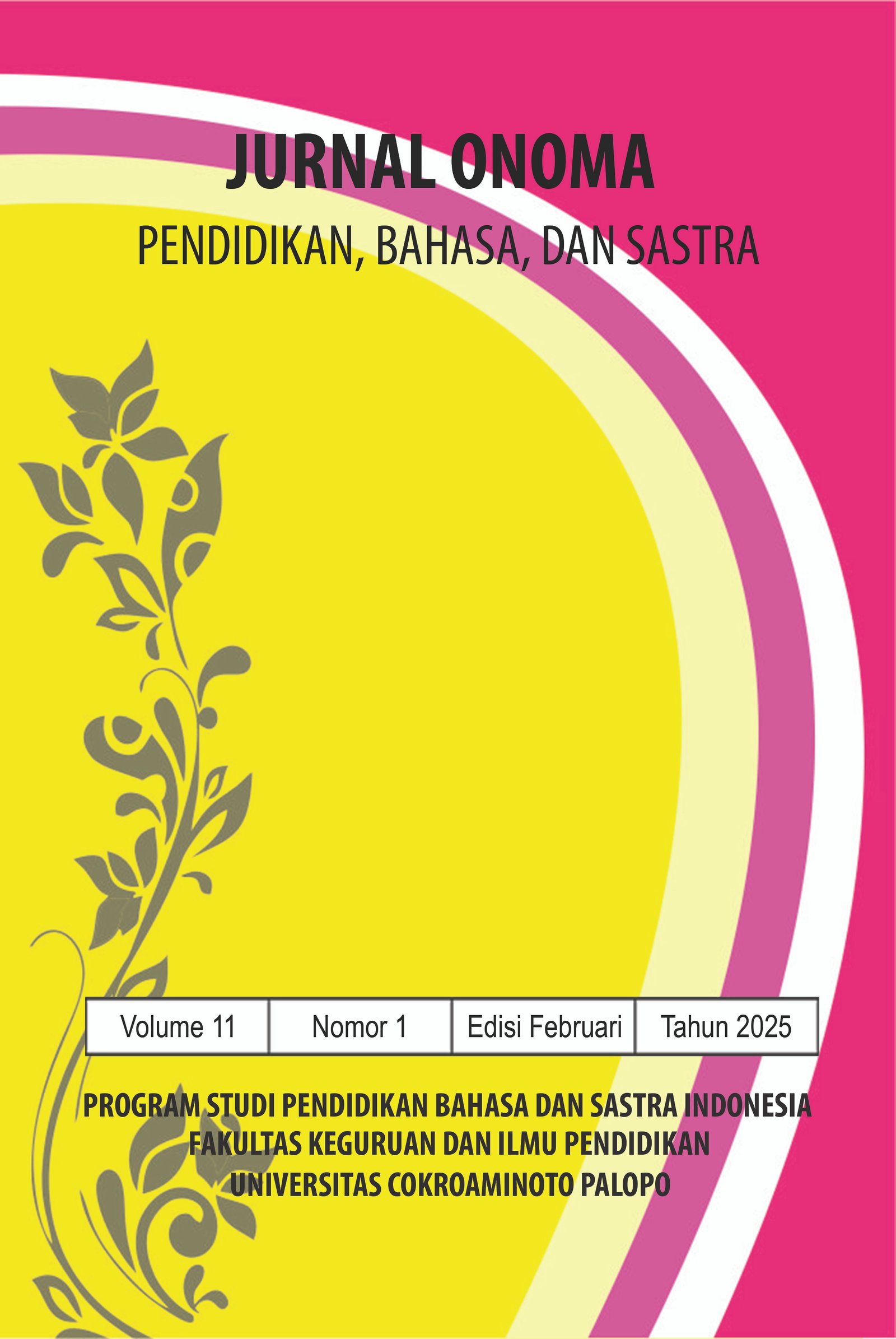Rekonstruksi Cerita Pendek Ikan Asin dan Mah Yong menjadi sebuah Naskah Sinema Pendek
https://doi.org/10.30605/onoma.v11i1.5204
Keywords:
rekonstruksi, cerita pendek, Ikan Asin dan Mah Yong, naskah sinema pendekAbstract
Tujuan penelitian ini adalah untuk mengkaji proses rekonstruksi cerita pendek Ikan Asin dan Mah Yong karya Rifan Nazhip menjadi sebuah naskah sinema pendek dengan menggunakan teori adaptasi. Penelitian ini menggunakan pendekatan kualitatif dengan metode deskriptif. Proses rekonstruksi menggunakan teori adaptasi Hutcheon. Berdasarkan hasil penelitian terdapat unsur cerita pendek berupa tema, alur, tokoh dan penokohan, latar, sudut pandang, dan amanat. Setelah proses adaptasi, hasil penelitian tersebut menunjukkan perubahan yang ditandai dengan adanya pengurangan, penambahan, dan perubahan bervariasi. Pengurangan cerita pendek dikategorikan menjadi dua, yaitu penyederhanaan alur dan pengurangan tokoh. Penambahan dikategorikan menjadi lima, yaitu penambahan karakter atau tokoh, struktur cerita, lokasi, dialog, dan adegan. Perubahan bervariasi cerita pendek terdapat pada nama tokoh, pada cerita pendek menggunakan kata ‘Aku’ berubah menjadi Agus dalam naskah sinema pendek. Dengan demikian, rekonstruksi cerita pendek menjadi naskah sinema pendek merupakan upaya untuk memperkaya dan memperluas pengalaman artistik cerita asli dalam format yang berbeda.
Downloads
References
Fakhrurozi, J. & Adrian, Q. J. (2021). Kajian dan Praktik Ekranisasi Cerpen Perempuan di Rumah Panggung ke Film Pendek Angkon. Deiksis: Jurnal Pendidikan Bahasa dan Sastra Indonesia, 8 (1), 31-40. DOI: https://doi.org/10.33603/dj.v8i1.4417
Harold, James. (2018). The Value of Fidelity in Adaptation. The British Journal of Aesthetics, 58(1), 89-100. DOI: https://doi.org/10.1093/aesthj/ayx041
Hidayati, P. P. (2010). Teori Apresiasi Prosa Fiksi. Bandung: Prisma Press Prodaktama.
Hutcheon, L. & O’Flynn, S. (2013). A Theory of Adaptation (Second Edition). New York: Routledge. DOI: https://doi.org/10.4324/9780203095010
Karkono. (2009). Perbedaan Makna Novel dan Film Ayat Ayat Cinta: Kajian Ekranisasi. Atavisme, 12(2), 167-180. DOI: https://doi.org/10.24257/atavisme.v12i2.168.167-180
Nazhip, Rifan. (2019). Ikan Asin dan Mah Yong. Kompasiana.
Nurgiyantoro, B. (2018). Teori Pengkajian Fiksi. Yogyakarta: Gadjah Mada University Press.
Nurhasanah, E. (2022). Kajian Alih Wahana Cerita “Kedai Kopi Odyssey” Karya Leopold A. Surya Indrawan menjadi Naskah Drama. DILOSIA: Jurnal Kajian Bahasa, Sastra, dan Pengajarannya, 5(2), 175-194. DOI: https://doi.org/10.30872/diglosia.v5i1.355
Pujiharto. (2012). Pengantar Teori Fiksi. Yogyakarta: Penerbit Ombak.
Sapiro, G. 2016. How Do Literary Works Cross Borders (or Not)?. Brill: Journal of World Literature, 1(1), 81-96. DOI: https://doi.org/10.1163/24056480-00101009
Siswanto, W. (2014). Cara Menulis Cerita. Malang: Aditya Media Publishing.
Suban, F. (2009). Yuk... Nulis Skenario Sinema. Gramedia Pustaka Utama.
Waluyo, H. J. (2017). Pengkajian Cerita Fiksi. Surakarta: Sebelas Maret University Press.
Downloads
Published
How to Cite
License
In submitting the manuscript to the journal, the authors certify that:
- They are authorized by their co-authors to enter into these arrangements.
- The work described has not been formally published before, except in the form of an abstract or as part of a published lecture, review, thesis, or overlay journal.
- That it is not under consideration for publication elsewhere,
- That its publication has been approved by all the author(s) and by the responsible authorities – tacitly or explicitly – of the institutes where the work has been carried out.
- They secure the right to reproduce any material that has already been published or copyrighted elsewhere.
- They agree to the following license and copyright agreement.
License and Copyright Agreement
Authors who publish with Onoma Journal: Education, Languages??, and Literature agree to the following terms:
- Authors retain copyright and grant the journal right of first publication with the work simultaneously licensed under Creative Commons Attribution License (CC BY 4.0) that allows others to share the work with an acknowledgment of the work's authorship and initial publication in this journal.
- Authors are able to enter into separate, additional contractual arrangements for the non-exclusive distribution of the journal's published version of the work (e.g., post it to an institutional repository or publish it in a book), with an acknowledgment of its initial publication in this journal.
- Authors are permitted and encouraged to post their work online (e.g., in institutional repositories or on their website) prior to and during the submission process, as it can lead to productive exchanges, as well as earlier and greater citation of published work.

















